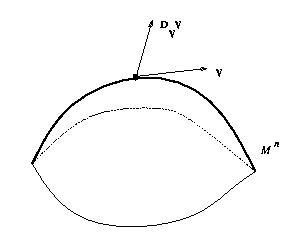MAT 4930 Section 1374, Spring 2014
Curves and Surfaces in Three-Dimensional Space: An Introduction to Differential Geometry
MWF 8th period (3:00-3:50), Little 233
For geometric objects in R3 it’s “intuitively obvious” what words like curved, straight, and flat mean. But as soon as you try to nail down these notions, you find some obvious questions that you (probably) don’t know how to answer. For example:
- How can you tell whether a curve lies in a plane? What about just a small segment of the curve? Can you quantify how non-planar a curve is?
- Given two curves in space, how can you tell whether one can be rotated and/or translated into the other (an analog of “congruence” in Euclidean geometry)?
- How can we quantify how curved a surface is?
- In a plane (a flat surface), the shortest path between two points is a straight line. On a curved surface, what is the analog of “straight line”?
- If you were a tiny person living on a sphere (as, essentially, you are), unable to look out into space, and unable to travel far enough to circumnavigate the globe, could you tell that your world was not flat?
- A cylinder can be slit and then rolled out flat onto a plane. So can a cone. But you can’t do this with a sphere, or even a small portion of a sphere, like a “polar cap”. (This is why maps of the earth always have distortion somewhere.) Why can we do this with cylinders and cones but not spheres?
- Suppose you have a sphere that’s “distortable”, like an exercise ball —you can poke it, stretch it, compress it, etc., but not tear it. If you try to flatten it out near one point, it will become more curved somewhere else. Does the “total curvature”, whatever that might mean, remain constant?
- A small enough neighborhood of any point on a sphere looks bowl-shaped, like a polar cap; no point has a saddle-shaped neighborhood. (Shape does not care about orientation in space; an upside-down or sideways bowl is still a bowl.) A standard torus, like the tire of a car, has some points near which the surface looks bowl-shaped (such as points along the outer rim) and some points near which the surface looks saddle-shaped (such as points along the inner rim). Suppose your torus is distortable. Can you mush it around in such a way that you get rid of all the saddle points? The answer is no, but how could you prove that?
In this course we will answer questions such as the ones above. Technical names for some of the topics we will cover are: the Frenet formulas; covariant derivatives; principal curvatures; Gaussian curvature and mean curvature; geodesics; holonomy around a closed curve; and (time permitting) the Gauss-Bonnet Theorem.In addition to being beautiful in its own right, the theory of curves and surfaces (which forms the basis of differential geometry) has many modern-day applications, including computer-assisted design, graphics, and animation. Higher-dimensional differential geometry also has great importance in many areas of theoretical physics, among them General Relativity.
Prerequisites for this course:
- MAC 2313, MAC 3474, or the equivalent (Calculus 3).
- MAS 4105 (Linear Algebra). NOTE:
- MAS 3114 (Computational Linear Algebra) DOES NOT meet the linear-algebra prerequisite.
- Prerequisite does not mean corequisite. All prerequisites must be completed successfully before taking this course.
Last update made by D. Groisser Thu Oct 31 18:50:37 EDT 2013
